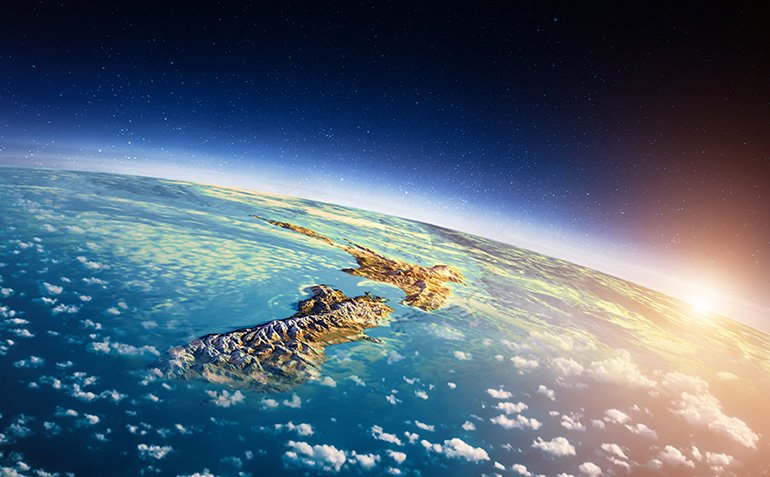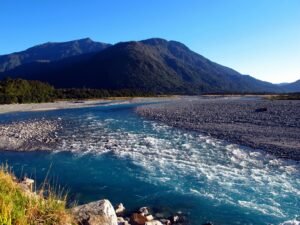New Zealand is known for its stunning landscapes, rich Maori culture, and friendly locals. New Zealand also boasts vibrant urban centers that contribute significantly to the country’s dynamic character. From the cosmopolitan hubs to the quaint provincial towns, New Zealand’s cities offer a diverse range of experiences. Let’s read about the top 10 biggest cities in New Zealand, uncovering their unique charm, cultural attractions, and economic significance.

Auckland
As New Zealand’s largest and most populous city, Auckland takes the crown as the country’s economic and cultural powerhouse. Nestled between two harbors, the city is known as the “City of Sails” due to its extensive maritime history and the numerous yachts dotting its shores. Auckland is home to iconic landmarks such as the Sky Tower, providing breathtaking panoramic views of the city, and the Auckland War Memorial Museum, showcasing the nation’s history and heritage.
The city’s vibrant cultural scene is evident in its diverse neighborhoods, each offering a unique atmosphere. From the trendy cafes and boutiques of Ponsonby to the bustling markets of Otara, Auckland caters to a wide range of tastes. The Auckland Art Gallery and the Auckland Philharmonia Orchestra further contribute to the city’s thriving arts and entertainment scene.
Wellington
Nestled between the North Island’s hills and the rugged coastline, Wellington, the capital city of New Zealand, is a compact metropolis with a rich political and cultural heritage. Renowned for its iconic harbor, the city is often subject to the whims of the notorious Cook Strait winds, adding to its distinctive character.
Wellington is a cultural hub, home to Te Papa Tongarewa, the national museum of New Zealand, showcasing the country’s natural, cultural, and artistic treasures. The city’s vibrant arts scene is celebrated through events like the Wellington Jazz Festival and the New Zealand International Film Festival. With its lively café culture and diverse culinary offerings, Wellington has earned its reputation as the “Coolest Little Capital in the World.”
Christchurch
Christchurch, on the South Island, is the largest city in the Canterbury region and has undergone significant transformation following the devastating earthquakes in 2010 and 2011. The city has embraced a resilient spirit, with innovative urban planning and reconstruction efforts leading to a revitalized downtown and vibrant community spaces.
Known as the “Garden City,” Christchurch boasts beautiful parks and gardens, such as the Botanic Gardens and Hagley Park. The Canterbury Museum and the Christchurch Art Gallery contribute to the city’s cultural landscape. The Avon River, meandering through the heart of Christchurch, adds a tranquil touch to the urban environment, with punt rides offering a unique perspective of the city.
Hamilton
Located in the Waikato region, Hamilton is New Zealand’s fourth-largest city and a major hub for agriculture and education. Nestled along the banks of the Waikato River, the city is often referred to as the “student city” due to the presence of the University of Waikato and Waikato Institute of Technology.
Hamilton Gardens, a premier attraction, showcases a variety of themed gardens, reflecting different historical and cultural styles. The city also boasts the vibrant arts and entertainment venue, Claudelands Events Centre, hosting concerts, exhibitions, and conferences. Hamilton’s proximity to Hobbiton, the film set for the Lord of the Rings and Hobbit trilogies, adds a touch of cinematic magic to the region.
Tauranga
As the largest city in the Bay of Plenty region, Tauranga is a thriving port city known for its beautiful beaches and pleasant climate. The city’s coastal location provides opportunities for water-based activities, and Mount Maunganui, a prominent volcanic cone, offers panoramic views of the region.
Tauranga’s economic significance is underscored by its bustling port, handling a significant portion of New Zealand’s exports. The city’s cultural scene is showcased in events like the National Jazz Festival and the Tauranga Arts Festival. With a burgeoning population, Tauranga is witnessing rapid growth, attracting residents with its relaxed lifestyle and economic opportunities.
Dunedin
Situated on the southeast coast of the South Island, Dunedin is known for its Scottish heritage, Victorian architecture, and proximity to the Otago Peninsula’s wildlife. The city is home to the University of Otago, contributing to its vibrant student population and energetic atmosphere.
Dunedin’s historic railway station, adorned with intricate mosaics, is a testament to the city’s architectural grandeur. The Otago Museum and the Dunedin Public Art Gallery offer cultural experiences, while the Royal Albatross Centre provides a unique opportunity to observe these majestic birds in their natural habitat. The Cadbury World attraction adds a sweet touch to Dunedin’s diverse offerings.
Palmerston North
Situated in the Manawatū-Whanganui region, Palmerston North is a key educational and research hub, home to Massey University and the Institute of Environmental Science and Research. The city’s central location makes it a crucial transportation hub and a gateway to the lower North Island.
Palmerston North’s cultural scene is enriched by the Te Manawa museum and art gallery, showcasing the region’s history, art, and science. The city’s expansive Victoria Esplanade Gardens provide a peaceful retreat, while the annual Festival of Cultures celebrates the diverse ethnic communities that contribute to Palmerston North’s multicultural fabric.
Napier / Hastings
Located in the Hawke’s Bay region, the twin cities of Napier and Hastings are renowned for their distinctive Art Deco architecture and thriving wine industry. Napier, often referred to as the “Art Deco capital of the world,” boasts a unique aesthetic resulting from the city’s reconstruction after the devastating 1931 earthquake.
The region’s vineyards, producing world-class wines, contribute to the area’s reputation as a premier wine destination. Events like the Tremains Art Deco Festival and the F.A.W.C! Food and Wine Classic celebrate the cultural and culinary richness of Napier-Hastings. With a Mediterranean-like climate and stunning coastal landscapes, the twin cities offer a delightful blend of history, culture, and natural beauty.
Rotorua
Nestled in the heart of the Bay of Plenty, Rotorua is renowned for its geothermal wonders, Maori culture, and outdoor recreational opportunities. The city is situated on the shores of Lake Rotorua and is surrounded by geysers, hot springs, and bubbling mud pools, creating a truly unique environment.
Rotorua’s cultural experiences are exemplified by the Te Puia Maori Arts and Crafts Institute, where visitors can witness traditional Maori performances and learn about indigenous art forms. The Redwoods Forest, offering world-class mountain biking trails, and the Skyline Rotorua gondola are popular outdoor attractions. With its distinct geothermal character, Rotorua remains a must-visit destination for those seeking a blend of adventure and cultural immersion.
Whangarei
Situated in Northland, Whangarei is New Zealand’s northernmost city, known for its subtropical climate, picturesque harbor, and rich marine life. The city serves as a gateway to the stunning Bay of Islands and is surrounded by native forests, providing ample opportunities for outdoor enthusiasts.
Whangarei’s cultural scene is reflected in the Claphams National Clock Museum and the Whangarei Art Museum.




